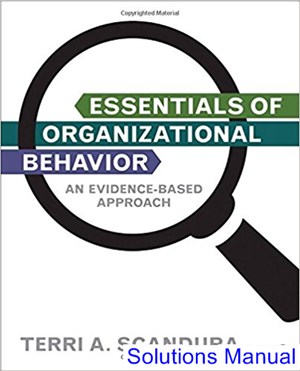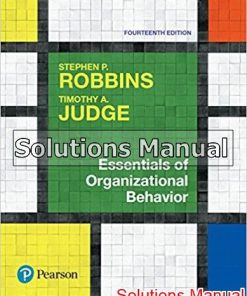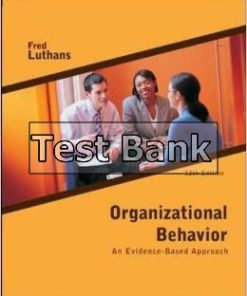Essentials of Organizational Behavior An Evidence Based Approach 1st Edition Scandura Solutions Manual
$26.50$50.00 (-47%)
Essentials of Organizational Behavior An Evidence Based Approach 1st Edition Scandura Solutions Manual.
You may also like
Essentials of Organizational Behavior An Evidence Based Approach 1st Edition Scandura Solutions Manual

Product details:
- ISBN-10 : 9781483345659
- ISBN-13 : 978-1483345659
- Author: Terri A. Scandura – University of Miami, USA
Essentials of Organizational Behavior: An Evidence-Based Approach equips students with the theory, research, and skills they need to be effective leaders and managers in today’s organizations. Author Terri A. Scandura utilizes a toolkit of real-life case studies, assessments, and exercises to teach students how organizational behavior can improve performance at every level in the workplace. With an emphasis on developing critical thinking skills and applying research to real scenarios, this book is a must-have resource for any student looking to enter the professional workforce.
Essentials of Organizational Behavior An Evidence Based Approach 1st Edition Scandura Test Bank
Table contents:
Section I: Organizational Behavior and Leadership
Chapter 1: What is Organizational Behavior?
Chapter Learning Objectives
A Crisis of Leadership?
What is Organizational Behavior?
Evidence-Based Management
What is Critical Thinking?
The Scientific Method
Outcome Variables in Organizational Behavior
Levels of Analysis in Organizational Behavior
How Organizational Behavior Can Increase Employee Performance
Toward More Effective Organizational Leaders: Plan for this Textbook
Leadership Implications: Thinking Critically
Chapter 2: Leadership: Core Concepts
Chapter Learning Objectives
Have Leaders Lost their Followers’ Trust?
What is Leadership?
Full Range Leadership Development
Leader-Member Exchange (LMX)
The Importance of Trust
Power and Influence
Organizational Politics and Political Skill
Ethical Leadership
Servant and Authentic Leadership
Leadership Implications: Developing Relationships and Leading Ethically
Section II: Understanding Individuals in Organizations
Chapter 3: Individual Differences
Chapter Learning Objectives
The Right Stuff at the Wrong Time
What is Personality?
Psychological Capital
Emotions and Moods at Work
Neuroscience
Diversity
Generations at the Workplace
Leading Diverse Followers
Mindfulness
Leadership Implications: Embracing Diversity
Chapter 4: Attitudes and Job Satisfaction
Chapter Learning Objectives
Job Satisfaction: A Downward Trend
What is an Attitude?
Do Attitudes Matter?
Job Satisfaction
Job Search Attitudes
Organizational Commitment
Perceived Organizational Support
Psychological Empowerment
Leadership Implications: Creating Meaning at Work
Chapter 5: Perception
Chapter Learning Objectives
Would you be Happier if You Were Richer?
What is Perception?
Understanding Why People Don’t See Eye to Eye
Attribution Theory
The Romance of Leadership
The Pygmalion Effect
Employability: How Potential Employers Perceive You
Leadership Implications: Leading Followers with Differing Perceptions
Chapter 6: Individual Decision Making
Chapter Learning Objectives
The Importance of Decisions
Decision Processes and Organizational Performance
The Rational Decision-Making Model
Prospect Theory
Intuition
Decision Traps
Creative Problem Solving
Leadership Implications: How Leaders Support Creativity
Section III: Motivating Employees
Chapter 7: Motivation: Core Concepts
Chapter Learning Objectives
Do You Have Grit?
What is Motivation?
Need Theories
Goal Setting
Job Characteristics Theory
The Importance of Fairness
Expectancy Theory
Path-Goal Theory
Leadership Implications: Leaders as Motivators
Chapter 8: Motivation: Learning and Rewards
Chapter Learning Objectives
The Meaning of Money
Reinforcement Theory
Social Learning Theory
Intrinsic vs. Extrinsic Rewards
What Money Can and Cannot Do
Performance Management
Problems with Performance Reviews
Feedback Seeking
Leadership Implications: Motivating with Rewards
Section IV: Building Relationships
Chapter 9: Group Processes and Teams
Chapter Learning Objectives
Why Teams Matter: “The Orange Revolution”
What is a Team?
Team Purpose
Team Development
Team Effectiveness
Cohesion
Team Norms
Team Mental Models
Participation in Team Decisions
Team Decision Making Methods
Team Challenges
Leadership Implications: Empowering the Team
Chapter 10: Managing Conflict and Negotiation
Chapter Learning Objectives
What are CEOs Getting Coaching For?
What is Conflict?
Conflict Resolution Styles
Team Conflict and Performance
Third-Party Interventions
Resolving Conflict Across Cultures
Negotiation
Leadership Implications: Perspective Taking
Chapter 11: Organizational Communication
Chapter Learning Objectives
“Thin-Slicing” a Conversation
What is Organizational Communication?
Barriers to Effective Communication
Communication Networks
Electronic Communication
Cross-Cultural Communication
Nonverbal Communication
Silence
Leadership Implications: The Management of Meaning
Chapter 12: Cross-Cultural Differences and Adjustments
Chapter Learning Objectives
Global Diversity: A Key Workforce Trend
What is Culture?
High-Context Versus Low-Context Cultures
Hofstede’s Cultural Values
GLOBE Studies of Cross-Cultural Leadership
Cultural Tightness-Looseness
Developing Global Leaders
Culture Shock
Cross-Cultural Adjustment for Expatriates
Leadership Implications: “Explain Before Blame”
Section V: Creating Change
Chapter 13: Stress in the Context of Organizational Change
Chapter Learning Objectives
“Road Warriors”
What is Stress?
Stress and Organizational Performance
Stress and Organizational Change
Sources of Work-Related Stress
Stress Episode
Stress is a Global Concern
Coping
Preventative Stress Management in Organizations
Leadership Implications: Helping Employees Cope
Chapter 14: Organizational Culture
Chapter Learning Objectives
When Elephants Learn to Dance
What is Organizational Culture?
National Culture and Organizational Culture
Strong Organizational Cultures
Socialization
How Employees Learn Culture
Organizational Climate
Leadership Implications: Changing Organizational Culture
Chapter 15: Leading Change
Chapter Learning Objectives
Helping Employees Embrace Change
Forces Driving Organizational Change
Planned Organizational Change
Organizational Subsystems Involved in Planned Change
Organizational Development
Resistance to Change
Leading Change
Effective Change Implementation
Leadership Implications: Creating Learning Organizations
Appendix: Research Designs used in Organizational Behavior
People also search:
Essentials of Organizational Behavior An Evidence Based Approach 1st Edition Scandura
essentials of organizational behavior an evidence-based approach
essentials of organizational behavior an evidence-based approach 3rd
Essentials of Organizational Behavior
Scandura Essentials of Organizational Behavior An Evidenc












